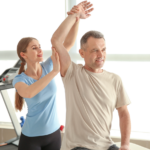The shoulder is among the most flexible parts of the body. It has ball and socket joints that allow you to rotate your arm in a circular motion and perform other duties like throwing a ball, lifting objects, brushing your hair, etc.
Unfortunately, the shoulders are prone to injuries at all ages, causing pain. The pain may originate from the joint or adjacent tendons, muscles, or ligaments. Shoulder pain at a young age is mainly due to injuries. However, the most common causes for seniors are rotator cuff tear and rotator cuff tendinopathy.
With that in mind, here are eight symptoms and treatment options for shoulder pain:
Symptoms
Shoulder pain may range from mild to extreme and can appear suddenly or intensify with time. With this, you may find it hard to carry out your daily activities. Therefore, knowing the symptoms for early diagnosis and treatment is crucial.
Here are some signs of shoulder pain:
- Sirva
Shoulder injury related to vaccine administration or SIRVA is a wound to the shoulder or upper arm resulting from improper vaccine injection. It typically occurs when a vaccine needle goes through the deltoid muscle to the bursa, resulting in constant shoulder pain, starting some hours after injection.
Mostly, SIRVA can heal independently, but sometimes, if left untreated, the pain may intensify, restrict shoulder mobility, and even cause dysfunction. Therefore, it’s vital to know what is SIRVA, the symptoms, and when to seek medication.
- Clicking Or Popping Sound In The Shoulder Joint
A popping or clicking sound on your shoulder joint is due to tendons and muscles shifting above the bone. Usually, it’s a sign that any of the muscles or tendons in your shoulder is injured and may result in pain.

- Burning Sensation
Another common symptom of shoulder pain is a burning sensation. It may signify shoulder tendonitis or bursitis. The former is an inflammation injury of your shoulder’s rotator cuff muscles. On the other hand, a bursa is a tiny fluid-filled sac found in soft tissues and bones that enable seamless movement.
- Extreme Pain At Night
Pain around your shoulder that deprives you of sleep at night is a sign of shoulder injury. It usually results from an inflammation or rotator cuff tear in your tendon sheaths. When tendon sheaths don’t release sufficient lubricants during motion, they become inflamed.
- Inability To Move Or Raise Your Arm Above your Head
Pain in your shoulder makes it weak and limits its motion. You may be unable to do simple tasks like zipping your jacket or lifting your arm over your head.
- Neck, Back, And Arm Ache
Sometimes, pain in your shoulder can extend to the nearest body parts like the arm, neck, or back. In this case, you may not readily notice the origin of the pain. Therefore, working with a specialist is vital to determine the cause and acquire the appropriate treatment.
- Swelling
You may notice swelling or redness within your shoulder’s peak and the arm bone’s apex. Mostly, this is due to overuse or injuries that result in fluids accumulating in the bursae, causing bursitis.
Treatment Options
There are various treatment options for shoulder pain, but the ideal one depends on the cause. Some standard options include the following:
- Ice And Heat Application
You may use ice packs to minimize pain and swelling from a severe shoulder injury. Also, you can use it to treat rotator cuff bursitis or tendinitis. In such cases, you apply ice immediately after overhead activity to reduce the emergence of inflammation.
Besides that, you can apply heat pads on your shoulder before the overhead activity to cure chronic shoulder issues. Heat can lower pain, relieve stiffness, and relax the muscles.
- Medications
Your doctor may prescribe drugs that can help ease pain or reduce inflammation. Some medicines include:
- Nonsteroidal Anti-Inflammatory Drugs (NSAIDs): These block a cyclooxygenase enzyme utilized by the body to produce prostaglandins. In doing so, NSAIDs help reduce shoulder pain and joint inflammation. Naproxen and Ibuprofen are examples of NSAIDs.
- Corticosteroid Injections: Your doctor can also suggest injections into your shoulder. Corticosteroid injection consists of two drugs: a corticosteroid that tentatively minimizes injection and boosts range of motion, and lidocaine, an anesthetic that relieves pain.
Before using drugs, enlist a professional’s help for effective prescription and avoiding side effects.
- Exercise
Some shoulder activities and stretches can help relieve pain and strengthen your shoulder. Some exercises include the following:
- Chest Expansion: This exercise is ideal for flexibility and shoulder mobility. While standing, place your hands behind you and hold a towel or strap. Then, slowly move your shoulder blades close to each other as you expand your chest.
- Seated Twist: Seat down on the floor with your hips facing forward and knees in line with your ankle. Place the opposite hand on your thigh and bend to one side. Stay in that position for some time and gently turn to stretch the opposite shoulder.
- Kid’s Pose: Kneel on the floor with your knees hip-width separated and toes together. Next, lower your torso towards your thighs and put your arms forward with the palms facing down. Rest your shoulders on the floor and relax for a few minutes.
- Neck Release: Lower your head towards your chest until your chin touches your chest. Next, slowly lift your head and lean on one side to stretch the opposite shoulder. Repeat this procedure on the opposite side.
- Doorway Shoulder Stretch: Place your elbows to form right angles in the doorway. Then, place one foot forward and slightly lean in front like you’re doing a pushup. Repeat this procedure several times and change to the other foot.
- Shoulder Circles: Stand straight with your hands parallel to the ground. Move your arms in a clockwise direction. Start at a small pace and gradually increase your speed. Repeat this in the anti-clockwise direction.
- Across The Chest Stretch: This is one of the most straightforward exercises that can help relieve shoulder pain. Put one of your hands across your chest and support with the other as you squeeze. Repeat this, on the other hand.
You can do these exercises at least thrice a week. Begin with shorter durations and slowly augment the duration as you get better. Exercise only to comfortable degree levels. If any exercise causes discomfort and extreme pain, you can discontinue it. However, ensure to stay motivated to exercise regularly and improve your condition.
Conclusion
Shoulder pain is common to all ages including those that are in senior living homes, and can result from various factors. It can affect your daily activities, and if unidentified immediately, it may cause serious shoulder issues. Therefore, knowing the symptoms and treatment options is essential. It allows you to pinpoint the cause and obtain the appropriate medications. Always consult a doctor for extreme or mild pain that lasts longer to give you a treatment plan.
Buy Me A Coffee
The Havok Journal seeks to serve as a voice of the Veteran and First Responder communities through a focus on current affairs and articles of interest to the public in general, and the veteran community in particular. We strive to offer timely, current, and informative content, with the occasional piece focused on entertainment. We are continually expanding and striving to improve the readers’ experience.
© 2024 The Havok Journal
The Havok Journal welcomes re-posting of our original content as long as it is done in compliance with our Terms of Use.



